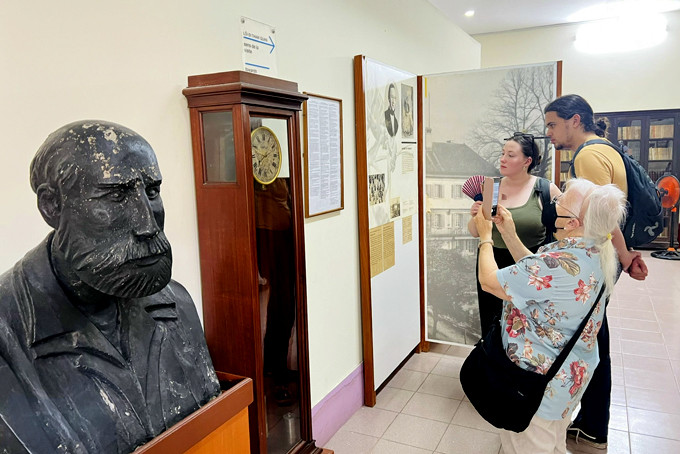
Alexandre Yersin Museum (A.Yersin Museum for short), located on the precinct of Nha Trang Pasteur Institute, houses many precious objects and photos about the life and career of Dr. Alexandre Yersin, who spent more than 50 years living and working in Nha Trang - Khanh Hoa. Foreign tourists to the museum are often impressed with the value of the museum.
Alexandre Yersin Museum (A.Yersin Museum for short), located on the precinct of Nha Trang Pasteur Institute, houses many precious objects and photos about the life and career of Dr. Alexandre Yersin, who spent more than 50 years living and working in Nha Trang - Khanh Hoa. Foreign tourists to the museum are often impressed with the value of the museum.
A place preserving things of Dr. Yersin
Foreign tourists in Nha Trang City visit A.Yersin Museum to learn about Dr. Yersin who discovered the plague bacillus, now called Yersinia pestis, and contributed to prepare anti-plague serum. “It is surprising that the museum of Dr. A.Yersin is located in the center of Nha Trang City. Visiting the museum, we know more about the life of A.Yersin and his contributions to Indochina and humanity”, said Michel Catherine, a tourist from the UK.

|
Despite its small area of about 100m2, A.Yersin Museum introduces almost the entire life and career of Dr. A.Yersin thanks to its scientific display. First, tourists will learn about the background of Dr. Yersin; contemplate the love letters he sent to his mother and sister; learn about the unspoiled lands through his travel and the process of his scientific researches with great achievements. Tourists will see the photos of Xom Con in the last years of the 19th century when the doctor arrived in Nha Trang and a model of his house and his simple room by the beach.
Additionally, the museum displays the equipment Dr. Yersin used for his scientific researches such as antique Leroy clock, books, morse code antenna, computer, globe, telescope and other experiment equipment. Especially, the museum preserves the microscope Dr. Yersin used to discover the plague bacillus in Hong Kong (China) in 1894 and the camera he used during his expeditions to Lang Biang plateau (Lam Dong Province) and surrounding areas, etc. Tourists can also learn more about the doctor through the information given by museum docent Cao Hoang Doan Thuc.
Needing to promote popularization
Most of the tourists visiting A.Yersin Museum are interested and impressed with the information about Dr. Yersin. They often buy souvenirs of the museum, which are mica keychains with Dr. Yersin's picture on them, postcards with pictures Yersin took, pen nibs engraved with the words A.Yersin Museum, etc. Some visitors leave their comments in the museum’s guest book before leaving the museum. Shellee, a visitor from Tasmania (Australia) wrote, “Visiting the museum, I have had a great discovery about A.Yersin's career. The objects and documents are extremely well preserved and the annotations are attractive. Thank you for preserving these precious artifacts.”
A.Yersin Museum has never been an attraction attracting many tourists. According to Cao Hoang Doan Thuc, even in the time when Khanh Hoa received a lot of foreign tourists, there were only more than 500 visitors to the museum per month. Currently, the museum only receives more than 300 visitors per month. This is a relatively small number compared to the number of visitors to other tourist attractions in Nha Trang City.
The province’s culture sector, tourism businesses and Nha Trang people need to popularize A.Yersin Museum and make it more popular to domestic and international tourists. Not only serving as a tourism product, A.Yersin Museum is also a homage of Khanh Hoa people to Dr. A.Yersin.
Xuan Thanh
Translated by H.N










